 Team Fur News
Team Fur News
The Storyteller
By FUR-FISH-GAME Editor, John D. Taylor

Photo: Matt Gibson/Shutterstock
He stood 6-foot 5-inches tall, and when I was a tall 13-year-old, he appeared as a giant to me. A Beatles-style mop-top of sandy blonde hair rode his head, and tinted wire-rimmed glasses covered his eyes. He was a young man, strong looking, yet soft in the places easy living can make a person soft. He wore the uniform of an outdoorsman of that era – blue jeans, flannel shirt, a down – no puffer – vest, work boots. Yet the thing that stood out most about him was the vitality literally bursting from him. Things were going on inside him, around him, above and below him. He wore an aura of mischief, tomfoolery, devilment – and outdoor adventure.
It was Christmas Eve of 1973, and he entered the kitchen from the back door in Grandma’s house, his girlfriend Karen in tow. In his wake was a stream of woodsmoke flavored with Old Bay seasoning and the scent of apples. He strode in like he owned the joint, with a huge smile and a big guffaw behind it. He threw a jovial insult at my uncle, his brother, who smiled and threw a better one back at him.
He was Billy, the storyteller.
Grandma’s white punch bowl was on the dining room table, ladle sticking out, with all kinds of food around it. And the singular scent of Grandma’s house permeated the air. There would be the meal, then church, then back to Grandma’s for opening all the presents stacked in front of the fireplace. Above the fireplace was what I imagined was Grandpa’s favorite piece of art, an old print of a father and son fishing in a mill pond with cane poles. Grandpa had passed away in March that year, so a note of sadness also colored the festivities.
After dinner, we sat around in the living room, talking. And when my uncle asked Billy about his caribou hunting trip in Alaska – Billy was becoming quite a well-known big game hunter, hobnobbing with the outdoor celebrities of the era, and taking many hunting trips – a light burst across his face. Here was his moment, his chance to take center stage and tell his story.
He looked at me, slapped his knee with his palm, a big gesticulation, and began the story.
“Awwwww, Johnny,” he said, pronouncing my name more like “Jawnny” than Johnny.
“You should have seen that. All them caribou. Hundreds of ‘em, thousands of ‘em, millions. Our guide kept saying, ‘Look, look... CARIBOU!’”
Billy tried to sound like the French-Canadian guide, pronouncing “look” more like “Luke,” and with more big gesticulations pointed to an imaginary herd of white and brown caribou snorting, lowing, antlers clacking, thundering across the tundra.
I have always possessed a whopper of an imagination, so I could almost see them, too.
“Awwwww, Johnny... I picked out the biggest bull, he was 800 yards away... no, more like 900. So, I pulled up my rifle and dropped him. One shot. Yeah, my aught-six is a good rifle. And then there was this grizzly bear. He was huge! He come out of the bush, and he tried to get my caribou. So, I run him off. Told him it was my caribou. That bear took off a-running. Awwwww... Johnny.”
Karen, watching Billy tell his story, rolled her eyes, while my uncle and the rest of the gathered crowd of family listened, faintly smiling. Karen often went along on hunting and fishing trips with Billy, and I suspected she may have had a slightly different version of his story.
I remember her – she was pretty – on a marlin boat my family chartered for a day, out of Ocean City, Maryland, a couple of years before Grandpa passed away. Grandpa, my uncle, great uncle Fred, Billy, Karen, Dad and I were the anglers. We went way out to sea, 50 miles offshore, to a deep ocean trench, and commenced dropping outriggers with teasers and two rods with big marlin-sized lures into the saltwater.
I was first up in the “fighting chair” because I was the kid – women and children first, you know. So, when we hooked a marlin, the captain told me to reel, reel like crazy, because that fish was running at the boat, instead of away from it. I did exactly that. The result was a very tired right arm, but no fish. The big fish spit the lure. Karen, up next, however, hooked and brought a mahi-mahi (a dolphinfish or dorado) to the boat. She was the only person who caught a fish that day.
Billy continued with his, “Look, look... Caribou!” story adding layer upon layer of happenings to the tale – the deprivations of camp life in the far North, additional sightings of other critters, and whopper stories about their antics. After about an hour of this, it was time to go to church, so we could get to those presents in front of the fireplace. Billy and Karen didn’t accompany us to church, though.
Through more holidays and special events – Easter, July 4th, a summer crab feed, etc. – I’d encounter Billy, usually with Karen, and would hear more tales of his outdoor prowess. I was told, and I believed it, that his trophy room was quite the experience. Billy didn’t just shoot big deer, bears, sheep or catch big fish. He always shot or caught trophies. There were a couple of state record trout, enormous whitetails taken in Texas, Anticosti Island or Alberta long before those places became well-known whitetail destinations, exotic game from Africa and other places in the world. Billy could afford to do this because he owned a mini-grocery store. It sold produce, seafood (especially crabs) in season, lottery tickets, and traded in local gossip and other things, some of which we heard were not quite lawful. Billy was developing a reputation for being something of a scofflaw, and to me at the time – remember, this was the 1970s, a time to rebel against authority – that only added to his appeal.
One tale Billy shared was about a Western black bear hunt. Billy said he and the outfitter hunted and hunted for this ginormous bear, and when they finally found the bear they were after, it was a long distance away, 700 yards according to Billy. The outfitter suggested getting closer, but Billy said he could make the shot with his trusty .30-06. (I never saw the rifle, but I believe it was a Model 700 Remington, similar to my uncle’s 7mm magnum.) Again, Billy claimed he laid the bear flat with a single shot from this rifle.
When I graduated from high school in 1978 – even though I didn’t achieve much – I was offered a present, a trip West to hunt big game. It never actually happened, but the February before graduation, Dad and I visited the Eastern Sports and Outdoor Show (now the Great American Outdoor Show) in Harrisburg, Pennsylvania, to talk with several outfitters about a potential big game hunt. One outfitter mentioned local references. When we told him where we lived, Billy's name came up – a reluctant reference, the outfitter said.
I shared Billy’s tale verbatim with the outfitter, how he rolled the bear with a single 700-yard shot from his .30-06. The outfitter smiled a big smile, shook his cowboy-hatted head, and told us the real story: He said Billy couldn’t hit the broad side of a barn door with his shooting. He used seven bullets to take that bear at 100 yards, missing with all but maybe the last two rounds. There was no 700-yard shot.
Wow... that really wilted my admiration of Billy. I lost a hero for a time. I began wondering how many other exaggerations he spewed. What was real, what was phony? I’d seen his trophy room full of all kinds of big game mounts and big fish on the walls. I had to wonder about the circumstances under which these animals and fish were acquired. Were they all seven-shots-at-100-yards instead of a single 700-yard shot?
For several years, Billy vanished from family gatherings. He and Karen parted ways after many years of being together. He had some trouble with the law over the grocery store and an incident involving big trout taken from a private stream. I wondered if the thrill of getting away with doing wrong, not the legitimate pursuit of real hunting or fishing, drove Billy’s outdoor passions.
As the years passed, my attitude towards Billy softened somewhat. I came to realize that those whopper stories he shared sparked some of my desire to experience the outdoors, especially the outdoors beyond Pennsylvania. I certainly didn’t want to be like Billy, not at all.
I couldn’t get into the trophy ideology. After all, what does a trophy really mean to the person who acquires it, or the people who see them? Is it ego? Is it a case of conspicuous consumption and trophies are a way to show that off, like fancy cars or big homes? Or does the hunter or angler genuinely seek the accomplishment of tagging an exceptional animal? It struck me that the feathers sticking out of a spent shotshell – the mark of an English setter’s first point – meant more to me than a magumba buck mount on some trophy hunters’ walls.
Billy’s stories were entertaining, for sure. Family still talks about them, mostly laughing at the hooey I didn’t see as a kid. Yet those stories had another impact. They sparked something with my writing. I wanted to tell authentic hunting, fishing or trapping stories, not tales, not fabrication, exaggeration full of phony superlatives.
I’ve stuck to that. Certainly, the sun may not have been shining as brightly as it seemed to me on special experiences I’ve related, the trout were smaller, the dog work might not have been as perfect as it seemed when I saw it, and the big buck I missed last fall might have grown a bit more antler than he would have had if he were on the ground, and I was about to field dress him. But I’ve told the truth as I saw it.
I’ll bet most families have a storyteller like Billy. Listen to their tales, enjoy the adventure, even while remaining skeptical of the reality of the tale. And if they spark a desire in your heart to know some adventure, go with it. That is the power of storytellers.
Poachers Busted in Two States
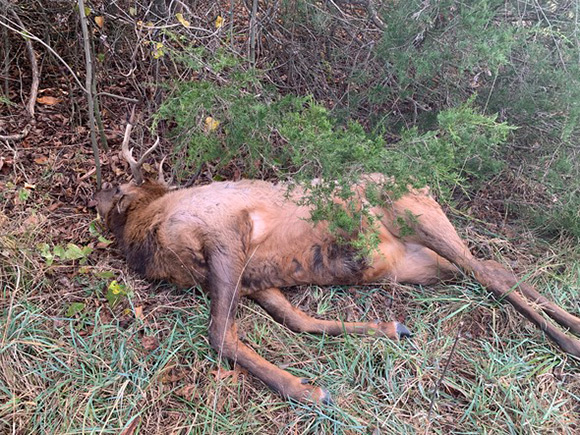
Three Missouri men were charged in the illegal killing of this bull elk.
Nine poachers in two states – Missouri and Montana – have been prosecuted for illegally taking big game.
In Missouri, three men connected to a 2023 illegal bull elk killing have been sentenced in Shannon County court: Michael K. O’Neail, of De Soto, pleaded guilty Sept. 3 to illegally killing and abandoning a bull elk. O’Neail was sentenced to 60 days in jail and ordered to pay a $10,000 fine. The 60-day jail sentence was suspended, pending successful completion of two years of probation and full payment of the $10,000 fine within a year of his sentencing. The two men not directly responsible for the elk poaching, Kevin B. Click and Travis R. Wadlow, both of Bonne Terre, each received a $500 fine plus court costs, and a mandatory $750 contribution to the Missouri Conservation Heritage Foundation for the illegal take or possession of whitetailed deer. In addition to the elk poaching, the trio was also charged for being in illegal possession of a deer they did not Telecheck.
The Missouri Department of Conservation’s (MDC) Protection Branch began its investigation after a teenage deer hunter reported finding the dead bull, near Klepzig Mill, during the November 2023 firearms deer opener. Over the course of nine months, MDC conservation agents interviewed numerous deer hunters, contacted local businesses, and reviewed surveillance footage and elk-monitoring camera footage to identify the suspects. As a result, five search warrants were served, numerous pieces of evidence were sent to forensics labs, and the three men were taken into custody. Public assistance was critical for bringing these poachers to justice. The Operation Game Thief (OGT) hotline – (800) 392-1111 – allows Missourians to protect nature by reporting poaching.
In Montana, six men from Montana and Washington were sentenced in a Musselshell County poaching case. This group illegally killed bull elk and mule deer bucks near Roundup. Collectively, they were sentenced to a combined total of $22,890 in fines, and license revocations totaling 28 years.
An investigation began with information provided to Montana’s Fish, Wildlife and Parks (FWP) Department wardens by a confidential informant. After an extensive investigation, wardens found the group killed several large bull elk without the required permit and several large mule deer without hunting licenses between 2020 and 2024. Montana wardens worked with wardens in Washington State and seized 11 mounts of unlawfully killed elk and deer. A total of 34 charges and 13 warnings were issued by FWP wardens. Four men from Tri Cities, Washington were sentenced to pay fines and restitution and received license revocations: Ben Valadez, $8,050 in fines and restitution, eight-year license revocation; Kyle Steiling, $3,640, four-year license revocation; Noa Valadez, $2,070, two-year license revocation; Johnny Lopez $1,805, two-year license revocation. Two Roundup, Montana men received similar sentences: Devon Rea, $4,275 in fines and restitution, four-year license revocation; Mitch Miller, $3,050, eight-year license revocation. Anyone with information about wildlife crimes is encouraged to visit tipmont.mt.gov. Those who report information may be eligible for a cash reward of up to $1,000.
Reciprocal Kentucky-West Virginia Fishing Agreement Reinstated

West Virginia anglers may once again use their resident fishing license to fish from the Kentucky side of the Big Sandy and Tug Fork rivers, provided they follow Kentucky fishing regulations.
In September, the West Virginia Division of Natural Resources (WVDNR) announced the reinstatement of its reciprocal fishing agreement with Kentucky. Under the agreement, West Virginia anglers may once again use their resident fishing license to fish from the Kentucky side of the Big Sandy and Tug Fork rivers, provided they follow Kentucky fishing regulations. The agreement only covers the main stem of these rivers. Anglers who utilize an embayment or tributary on the Kentucky side must purchase a Kentucky fishing license. WVDNR also has a reciprocal fishing agreement with Ohio and Maryland on the Ohio and Potomac rivers. Visit WVdnr.gov/fishing-regulations or WVfish.com for more information about reciprocal fishing agreements.
Avian Influenza To Hit North Carolina
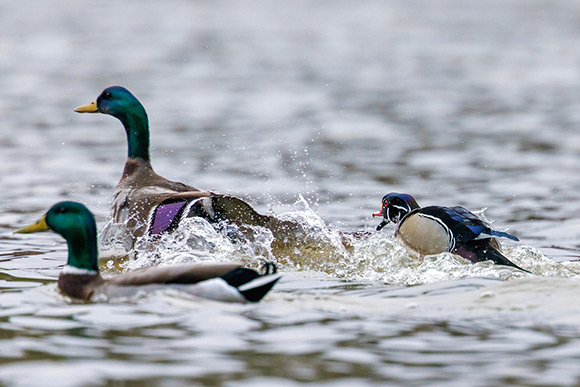
North Carolina’s Wildlife Resources Commission anticipates new cases of HPAI to emerge due to waterfowl migrations.
The North Carolina Wildlife Resources Commission (NCWRC) is anticipating new cases of the highly pathogenic avian influenza (HPAI) to emerge due to the high numbers of migratory waterfowl and other birds that pass through or congregate in the state during winter. NCWRC monitors HPAI and is urging hunters, especially waterfowlers, along the Outer Banks and other coastal areas to be careful. This important wintering area for many waterfowl species is where NCWRC Wildlife Health Biologist Miranda Turner expects the combination of good habitat and migratory activity to create the environment for the virus to spread. HPAI is cold-hardy, able to proliferate during winter. The birds most likely to be found with HPAI are waterfowl, shorebirds and raptors, with less frequent cases in songbirds and mammals. Since early 2022, NCWRC has detected the virus in 413 wild birds and one black bear. At the start of the fall migration, NCWRC confirmed HPAI in black vultures in Iredell County and suspected cases in black vultures in Union County. HPAI symptoms vary, but include ocular and nasal discharge, coughing, difficulty breathing, diarrhea, lethargy, loss of coordination, walking or swimming in circles, head and neck twisting and wobbling, paralysis, swollen and discolored neck, head and feet. The public shouldn’t approach any animals that appear sick or are behaving unusually. Also, prevent pets from interacting with any sick or dead animals. Hunters should not harvest or handle game birds that are obviously sick, and wear gloves when handling and dressing any harvested birds. Inedible parts should be buried or disposed of in the trash. Wash hands and tools with soap and water or disinfectant wipes. Cook all game meat thoroughly prior to consumption. To report suspected HPAI, especially where six or more dead wild birds are found in one area within a couple weeks, call the N.C. Wildlife Helpline at (866) 318-2401 or email HWI@ncwildlife.gov.
Idaho Hunters Lose 30,000 Panhandle Acres Through Land Sales
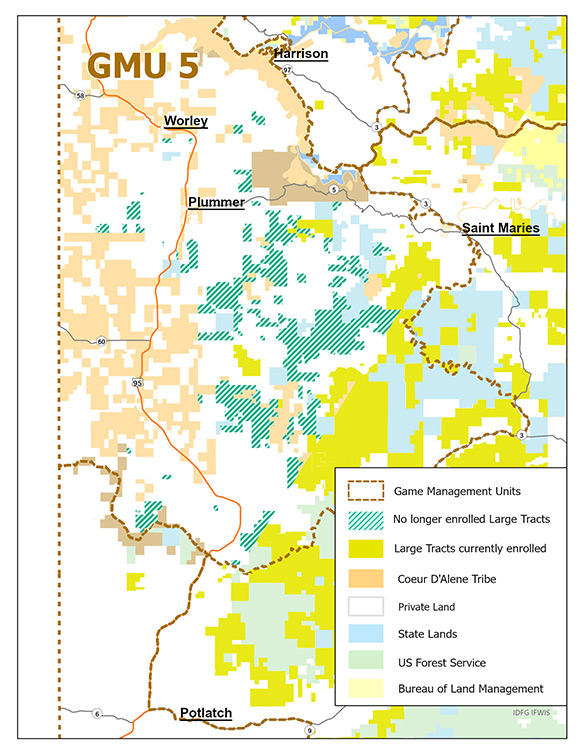
In late September, land sales in Idaho’s Game Management Unit 5 – the Panhandle region – removed nearly 30,000 acres of private land, previously enrolled in the state’s Large Tracts Program and open to hunting, from the program. The land was owned by Stimson Lumber. It was sold to the Coeur d’Alene Tribe. The land is located on the Coeur d’Alene Reservation and has always been an important part of the tribe’s homeland. Entering any private land while access is closed or restricted is trespassing. For more information about hunting on lands owned by the Coeur d’Alene Tribe, hunters are encouraged to contact the tribe directly. These sales are a reminder that all Large Tracts parcels are private lands and can change ownership at any time. Outdoor people should never assume last season’s access is still valid. Always confirm land status before your trip by checking the Idaho Hunt Planner. All Large Tracts lands are privately owned and only accessible to the public due to partnerships between Idaho Fish and Game (IFG) and private landowners. Private landowners set rules for their lands, not IFG.
Hunters Encouraged To Be Aware of New World Screwworm
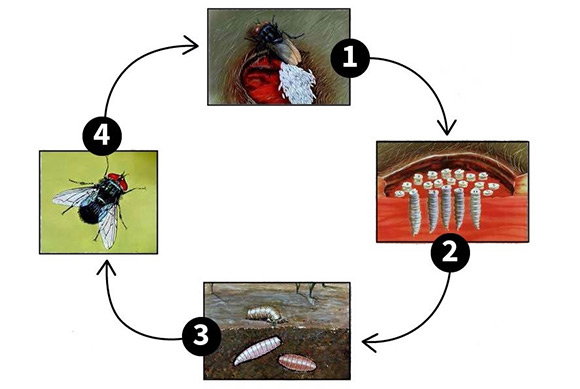
The New World Screwworm life cycle: 1.) eggs are laid in a wound, 2.) maggots develop, 3.) maggots eat tissue until, 4.) they grow into adult flies.
The New Mexico Department of Game and Fish (NMGF), and the state’s agriculture department and livestock board are encouraging hunters to help prevent the spread of New World screwworm. New World screwworm (Cochliomyia hominivorax) is a foreign animal disease and poses a serious threat. The fly’s larvae infest open wounds, where they feed on living tissue. The New World screwworm (NWS) was eradicated from the United States decades ago, but recent detections in Mexico pose a risk of northward spread. It has not been detected in the United States yet. Hunters should check harvested game and live animals for larvae (maggots). Unlike other maggots, NWS larvae feed on living tissue like wounds or body openings and will vacate an animal once it has died and the tissue begins to cool. Should you find NWS, do not eat, handle or transport the animal. Take a GPS location and photos of the wound or larvae. Also, collect, if possible, a sample of the larvae in a sealed container. Report the location and submit what you found to NMGF, (888) 248-6866 or ispa@dgf.nm.gov, the state agriculture department (575) 646-9191 or the livestock board (505) 841-6161.
New Maine Area Has ‘Do Not Eat’ Game Consumption Advisory
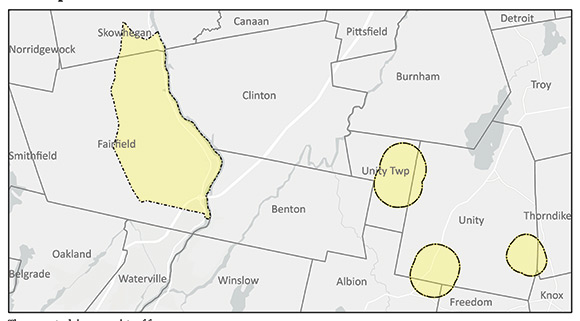
The Maine Department of Inland Fisheries and Wildlife (MDIFW), in conjunction with the state Department of Health and Human Services, and the Maine Center for Disease Control and Prevention, have issued a “Do Not Eat Wildlife Consumption Advisory” for portions of the towns of Knox, Thorndike and Unity. This new advisory area is in addition to the current advisory areas in portions of the towns of Fairfield, Skowhegan, Unity, Unity Township, Albion, Freedom, Knox and Thorndike. The new consumption advisory area was based on deer and turkeys tested in eastern Kennebec and western Waldo counties. MDIFW sampled wildlife for PFAS and found that wildlife living within a mile of areas with high soil PFAS concentrations resulted in animals with high levels of PFAS in their muscle tissue. This prompted the advisory. Maine recommends that no one eat deer or wild turkey harvested in these wildlife consumption advisory areas. PFAS, “forever chemicals,” are very slow to break down. Over time, exposure to PFAS has been known to increase the risk of some types of cancer, decrease infant and fetal growth, increase cholesterol levels and impair the immune system. Visit www.maine.gov/ifw/hunting-trapping/hunting/laws-rules/pfas-related-consumption-advisory.html, email FW.PFAS@maine.gov or call (207) 287-8000.
Ohio’s Turkey Poult Index
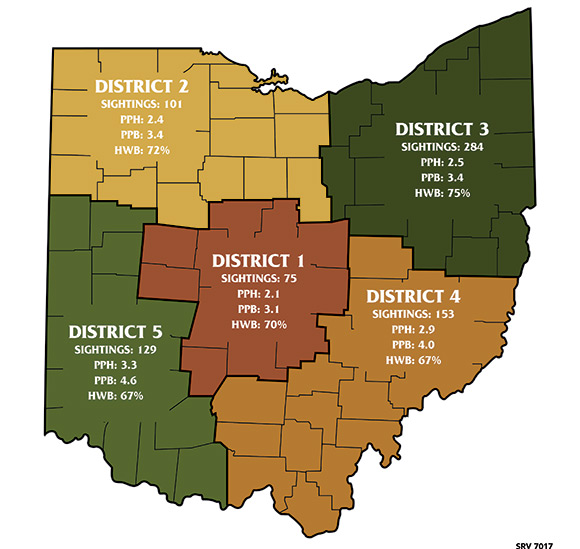
The Ohio Department of Natural Resources (ODNR) relies on public reports of wild turkeys and their young in July and August of each year to estimate nest success and poult survival. The annual poult index can serve as an indicator of wild turkey population trends and inform harvest regulations in future years. For 2025, the wild turkey poult index was 2.7 poults per hen. The 10-year average for poults per hen is 2.8. The slightly below average brood results follow four consecutive years of above average results. Wild turkey brood surveys in 2021 (3.1 poults per hen), 2022 (3.0), 2023 (2.8), and 2024 (2.9) showed strong nest productivity. The long-term average increased in 2024 because of recent turkey nest success. Regionally, ODNR notes, different regions reported differing numbers: southwest Ohio saw 3.3 poults per hen; southeast, 2.9; northeast, 2.5; northwest, 2.4; central, 2.
Wildlife Diseases Hitting Three States
.jpg)
North Carolina reported the first presumptive case of CWD in Edgecombe County in November.
North Dakota’s Game and Fish Department (NDGF) will continue its Hunter-Harvested Surveillance program for Chronic Wasting Disease (CWD) during 2025 by sampling deer for chronic wasting disease from units 3A1, 3A2, 3A3, 3B1, 3B2, 4A, 4B and 4C in the northwestern part of the state. Outside this area, hunters can still have their animal tested by taking it to a NDGF district office, a deer head collection site, or by using a self-sampling kit. Visit https://gf.nd.gov.
In In North Carolina, the state Wildlife Resources Commission (NCWRC) reported the first presumptive case of CWD in Edgecombe County in November. A preliminary positive test on a 3-1/2-year-old hunter-harvested whitetail buck in the eastern corner of the county was received. The closest confirmed location from this new site is 92 miles away, in Cumberland County. The deer was harvested a few miles from the Pitt and Martin county line. If confirmed as positive, it would be the 35th CWD-positive deer found in North Carolina since 2022. NCWRC monitors CWD to minimize its impact. CWD is transmissible and spreads through infected body fluids. NCWRC asks hunters to submit deer harvested in Edgecombe and surrounding counties for testing as part of this surveillance. During the past four years, NCWRC has tested samples from nearly 3,000 deer for CWD in Edgecombe and surrounding counties. Visit ncwildlife.gov/CWD
The Missouri Department of Conservation (MDC) is actively monitoring reports of sick and dead waterfowl for Highly Pathogenic Avian Influenza (HPAI). HPAI spreads among birds through contact with infected feces, saliva or nasal discharges. Migratory birds traveling through Missouri can carry the virus and it can move between wild birds and domestic poultry. Symptoms include tremors, head tilting, lethargy, loss of coordination, inability to fly or walk properly, or trouble standing upright. The risk from HPAI to the general public remains low, but sporadic human infections have occurred. MDC encourages hunters to dress harvested game birds in the field or in an area away from poultry and other birds, dispose of carcasses in trash or at a permitted landfill, and to allow all hunting gear, boats and waders to dry completely between trips to help prevent spreading the virus between locations. Report sightings of dead geese, other waterfowl, raptors, or other large birds at mdc.mo.gov/4KD.
Arizona Quail Numbers Down
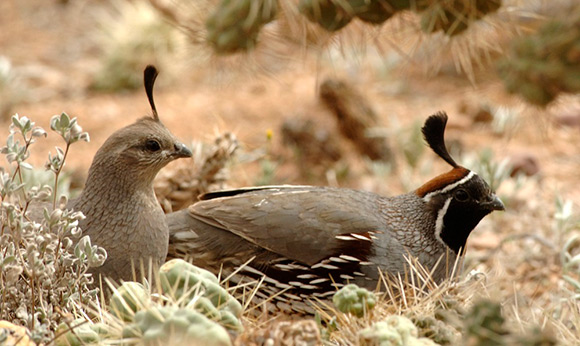
Arizona’s quail numbers are down and AZGFD is urging hunters to use restraint, take fewer, Montezuma (Mearns’) quail in particular.
Quail hunters were hoping record-setting rains that soaked most of the state last fall would boost Arizona’s quail numbers. It’s possible more rain might. Quail have the ability to quickly recover with adequate precipitation. However, it’s shaping up to be a tough year for Gambel’s, scaled and California quail hunters in Arizona. The statewide general season runs through February 8, 2026. Extremely dry conditions, said Dr. Larisa Harding, small game program manager for the Arizona Game and Fish Department (AZGFD) have impacted desert quail numbers. Following last winter’s low precipitation, there was virtually no “green-up” in the spring to support breeding activity or chick-rearing. As a result, annual spring call counts for Gambel’s quail were low, indicating less breeding and reproduction. Those call counts are a good predictor of what hunters can expect to see in the fall, Hardin noted. Also, AZGFD is encouraging hunters to “voluntarily exercise restraint” and harvest fewer birds than the limits allow and limit harvests within individual coveys of Montezuma (or Mearns’) quail, when the season begins December 5. Visit www.azgfd.com/species/quail for more information.
Michigan Considers Longer Elk Season

Michigan elk hunters could get a longer season if proposals under consideration by MDNR and the state Natural Resources Commission are approved.
Michigan elk hunters may get a longer elk season in 2026-2027 under a draft proposal by the Michigan Department of Natural Resources (MDNR). The proposal would lengthen both elk hunting periods in the northern Lower Peninsula, home to Michigan’s elk herd. Hunt Period 1 would run from the second Saturday in September through the second Sunday in October – a 30-day, continuous period. Currently, Hunt Period 1 is broken up into three, four-day hunts stretching across August and September, 12 total hunting days. Hunt Period 2 would run from Dec. 1 through Dec. 15 – a 15-day period. Currently, Hunt Period 2 runs from Dec. 13 through Dec. 21, a nine-day period. Combined, the two hunting periods would provide 45 total days of harvest time, more than double the current 21 total days. Another proposed change would give hunters 72 hours to register their elk harvest, not the current 24-hour period. The proposals, which do not affect the 2025-26 elk hunting season, must be approved by the Michigan Natural Resources Commission (NRC). MDNR welcomes public feedback on these proposals. Email DNR-Elk-Hunt@Michigan.gov by January 23, 2026. Final regulations would be adopted at the April 2026 NRC meeting.
Potter County, Pennsylvania, Bear
100th Anniversary Article from May 1926
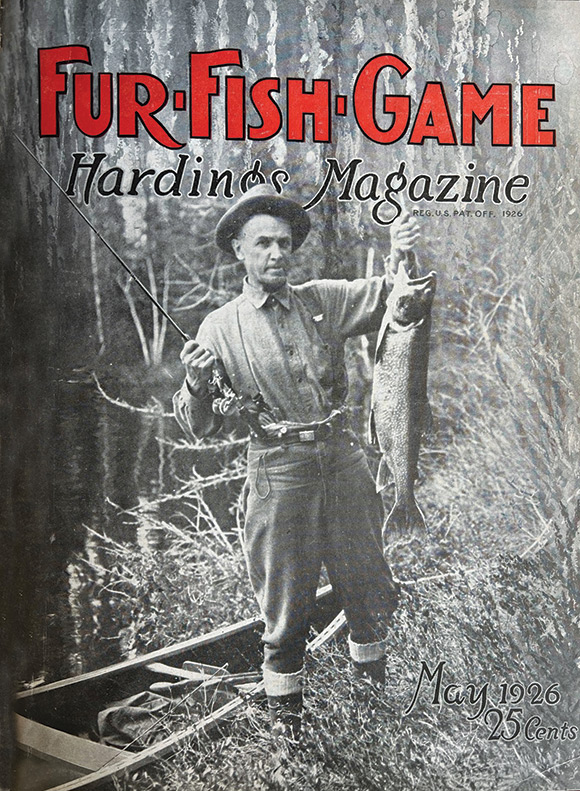
By Byron E. Cottrell
Pennsylvania’s Potter County has a great reputation as a bear country. In fact, it is claimed that in the hunting season of 1924, more black bears were killed in this county than in any other county in the whole United States. Without doubt this was not true, but if it was, it was due to a combination of circumstances that do not exist every year, and it gave many a man the wrong impression. Many bear hunters came here in the fall of 1924 that went away without even seeing a bear. It requires a lot more knowledge of the game to be a good bear hunter than it does to be an equally good deer hunter, and even then, there is a lot of luck in bear hunting – as much or more than in any other kind of hunting.
In 1924, there were all kinds of bear feed here in great quantities. All summer there were berries – more than they could eat – and then in the fall there came a larger crop of nuts than we had in several years. Bears go where the feed is, so in the fall of 1924, they were in Potter County. The next year, there were plenty of berries and lots of bears in the summer. But there were no nuts at all, and practically no apples. So, in the early fall, bears had to begin to hustle around to get anything to eat. Most of them went farther south where there was a good crop of acorns.
The few bear that did stay had to eat whatever they could get. One large old fellow went so far as to kill a milch cow out in the farming country, and fully 10 miles away from regular bear country. I heard of it the next day, but did not believe it at first, as I never before heard of a bear killing a cow – that is a black bear. Finally, however, I drove up to see for myself, and sure enough, there was a fine, large, red and white cow with her neck all chewed up, and hole eaten out of her back. The evidence plainly showed that it was a bear. He had first attacked the cow in the woods on a steep hillside, and the cow had gone down the hill about 100 yards before the bear had stopped her. The owner heard her bawling but did not dare to go out.
A few nights later this same bear visited a bee yard (owned by my father-in-law) and helped himself to honey. He lived pretty high for a few days until the game wardens set some No. 5 Newhouse traps for him, then he knew he had to leave. He never visited the cow or the honey after the traps were set.
As you likely know, this state protects bears as much as it does deer. It stopped trapping a long time ago, and now it protects baby bears. This is as it should be. And to show you how fair and square a State Game Commission can be, I will tell you what they did in the case of the bear described above. They always pay any damages done by bear within the past year. The owner of the cow put in his claim for damages that were actually less than the cow was worth. He told me himself that he thought he would be more apt to get his claim. He said he didn't want to play hog just because he had a chance. Well, he got his claim paper back and was told his claim was very low. They thought it possible the cow might have been worth more money. If she was, they would like to have him raise his claim to the value of the cow.
Now, how is that for a square deal? Of course, the two local wardens that saw the cow and knew she was worth more than the claim, likely had something to do with it, but it shows that the Game Commission wants to be fair. And this is why they have the good will of many farmers, as well as the sportsmen of the state. If I remember right, the first claim put in by the owner was $40. He raised this to $60, a price at which he could have easily sold the cow the day before she was killed.
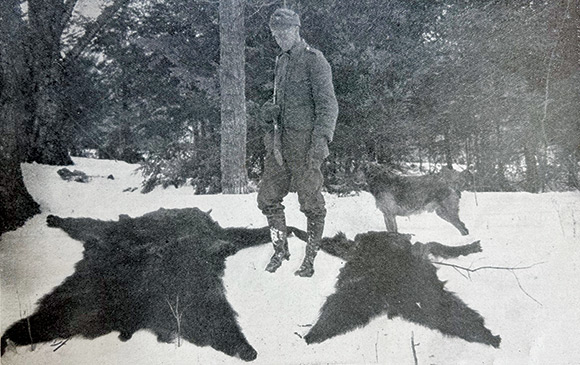
This bear was hunted and trapped for some time, but no one ever got him. After the hunting season on bears opened, he was never seen again. an outlaw bear like this can be hunted and trapped at any time, but the bear, if captured must be turned over to the state. One warden once tried to keep a skin thus caught for himself, and got caught at it, and lost his job.
Don't come to Potter County hunting bear with the idea that you are going to get one for sure. You might hunt for 10 years straight and not see one. But as a rule, a party of good bear hunters in a good locality (not all of Potter County is good bear country), will get one or two bears during a two-week hunt, but there are many such parties that do not.
UPCOMING EVENTS
Maine Trappers’ Association
The Central Maine Chapter of the Maine Trappers’ Association will hold its annual Fall Fur Auction, December 14, at the Palmyra Community Center, 768 Main St., Palmyra, Maine. Doors open at 7 a.m. Contact Ted Perkins at (207) 570-6243.
New York State Trappers’ Association
Two New York State Trappers’ Association affiliates, The Foothills Trappers and Fulton Mongomery Trappers, will hold their annual fur auction January 3, 2026, at the 4-H Building located at 556 Middleline Rd., in Ballston Spa, New York. Call Neal Sowle (518) 883-5467 or Paul Johnson at (315) 867-6565 for information.
Pennsylvania Trappers’ Association
District 10 of the Pennsylvania Trappers’ Association will hold a fur sale, January 17, at The Stockertown Rod and Gun Club, located at 206 Lefevre Road, in Stockertown, Pennsylvania. Doors open at 8 a.m., the sale starts at 9 a.m. Contact Bob at (610) 759-9203 for more information.
Indiana State Trappers’ Association
The Indiana State Trappers’ Association (ISTA) 2026 Fur Sale will hold two fur sales in 2026. The first will be held January 31, 2026, at the Selvin Community, 11900 Yellowbanks Trial, in Dale, Indiana. (Note the change of location.) The second will be held February 14, at the Miami County Fairgrounds, 1029 W 200 N, in Peru, Indiana. You must be an ISTA member to sell furs. Lot numbers can be purchased prior to the sale, and buyers will be coming in from several states. Both events include food, trap raffles and 50/50 contests. Doors open at 8 a.m. Sales begin promptly at 9 a.m. local time. Dale is in the Central Time Zone and Peru is in the Eastern zone. For more information, call or text Byron Tiede (219) 863-3803.
West Virginia Trappers’ Association
The West Virginia Trappers’ Association will hold their annual Spring Fur Auction March 6 - 8, 2026 at the Gilmer County Recreation Center, 1365 Sycamore Run Road, in Glenville, West Virginia. Vendors will be present throughout the weekend. Consignment for finished fur, roots, deer horns etc., begins at 9 a.m., Friday, March 6, and on Saturday, March 7. The fur auction will be held Sunday at 1 p.m. Ginseng will be sold to individuals outside, and not through the WVTA auction. Admission is free, all are welcome. Contact Jeremiah Whitlatch (304) 916-3329 or visit www.wvtrappers.com
Virginia Trappers’ Association
The Virginia Trappers’ Association (VTA) will hold its Eastern fur sale on March 14, at 12400 Herndon Rd, in Spotsylvania, from 7 a.m. until finished. Inspections begin at 8 a.m., the auction starts at 9 a.m. Same day registration is available. Also, on June 5 and 6, 2026, VTA will hold its annual Rendezvous at the Rockingham County Fairgrounds, 4808 S. Valley Pike Rd., in Harrisonburg. Call or text Craig Kunkel at (540) 539-1409 for more information.
Coming in our January 2026 Issue
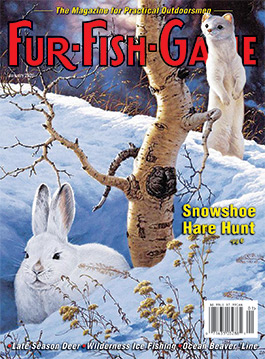
Features
• On The Hunt For Snowshoe Hares - John Murray explores snowshoe hare hunting with a .22 and discovers the forest’s rich rewards.
• Late Season Deer - Texas is the place to fill your freezer with venison in the late season, says Luke Clayton, especially with a muzzleloader.
• Oceanside Beaver Trapping - Serge Lariviere traps ADC beavers on Anticosti Island’s inlets to the Atlantic Ocean. It’s a different variety of beaver trapping.
• Trapping Turkeys - Scot Dahms spent several winters working for the Iowa DNR including trapping turkeys to transfer to other states.
• Go Hand-Drill A Hole Through The Ice - Rachel Langley and her father traveled by dogsled to spear pike in Minnesota’s Boundary Waters Canoe Area Wilderness.
• No Bones About It - The Goes clan, led by Phil, takes to the lake to catch a mess of hammer- handle pike... and do some family bonding.
Other Stories
• Still Hunting After All These Years... – Wes and Sharon Childers, in their 70s, are still hunting, despite numerous physical challenges.
• In Defense of Chum Salmon – Lucas Byker shares why he likes to catch chum salmon.
• Mesa Gold, Chapter 5
• The Higher Power Buck – Scott Crynock used his dying father’s Marlin 336 in .35 Remington to tag the buck of a lifetime, one he could share with his father before he passed, courtesy of a higher power.
• Make A Free European Skull Mount – Stephen Barron explains how to do a DIY free European skull mount… for free.
• Understanding Canine Set Locations – Andrew Zysek relates fall canine behaviors to the best trapping spots.
• The Last One Left – Cody Baumler shares his experiences with a series of trapping partners and why he still traps, even without a partner.
• A Different Kind Of Hunt – Curt Raymond uses a blackpowder hammer shotgun to hunt waterfowl and comes away with some wood ducks.
• More Is Not Always Better – Thomas Edgington had dozens of big mule deer bucks in front of him on an Alberta bowhunt, but connecting on the right buck didn’t prove as easy as he thought it might.
• Unemployed – Jospeh Sigurdson shares a tale of moving from Alaska to upstate New York, hunting a new job, then filling the hours between sending out resumes and hoping for a callback from employers, with ruffed grouse hunting. All seems for naught, until one day, when an employer calls, and he learns to be careful of what you wish for.
End of the Line Photo of the Month
Willey Matt Willey, Delta junction, Alaska
Subscribe to this newsletter
Put Subscribe in the subject line and include your first and last name.
SUBSCRIBE TO FUR-FISH-GAME Magazine



